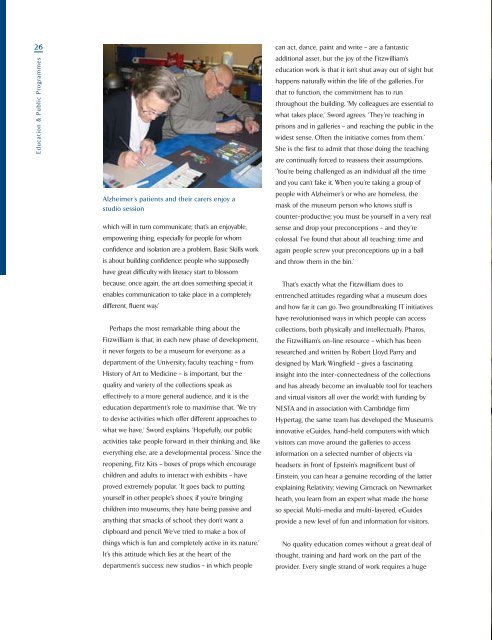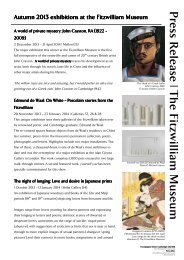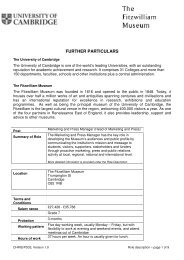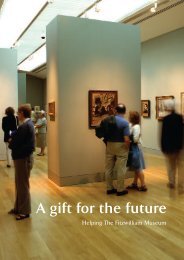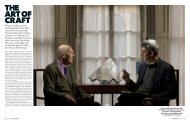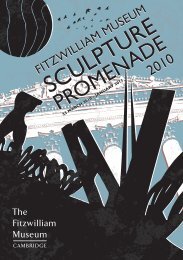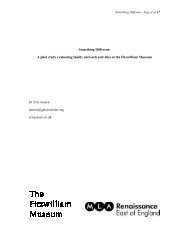The Fitzwilliam Museum - University of Cambridge
The Fitzwilliam Museum - University of Cambridge
The Fitzwilliam Museum - University of Cambridge
You also want an ePaper? Increase the reach of your titles
YUMPU automatically turns print PDFs into web optimized ePapers that Google loves.
26<br />
Education & Public Programmes<br />
Alzheimer’s patients and their carers enjoy a<br />
studio session<br />
which will in turn communicate; that’s an enjoyable,<br />
empowering thing, especially for people for whom<br />
confidence and isolation are a problem. Basic Skills work<br />
is about building confidence: people who supposedly<br />
have great difficulty with literacy start to blossom<br />
because, once again, the art does something special; it<br />
enables communication to take place in a completely<br />
different, fluent way.’<br />
Perhaps the most remarkable thing about the<br />
<strong>Fitzwilliam</strong> is that, in each new phase <strong>of</strong> development,<br />
it never forgets to be a museum for everyone: as a<br />
department <strong>of</strong> the <strong>University</strong>, faculty teaching – from<br />
History <strong>of</strong> Art to Medicine – is important, but the<br />
quality and variety <strong>of</strong> the collections speak as<br />
effectively to a more general audience, and it is the<br />
education department’s role to maximise that. ‘We try<br />
to devise activities which <strong>of</strong>fer different approaches to<br />
what we have,’ Sword explains. ‘Hopefully, our public<br />
activities take people forward in their thinking and, like<br />
everything else, are a developmental process.’ Since the<br />
reopening, Fitz Kits – boxes <strong>of</strong> props which encourage<br />
children and adults to interact with exhibits – have<br />
proved extremely popular. ‘It goes back to putting<br />
yourself in other people’s shoes; if you’re bringing<br />
children into museums, they hate being passive and<br />
anything that smacks <strong>of</strong> school; they don’t want a<br />
clipboard and pencil. We’ve tried to make a box <strong>of</strong><br />
things which is fun and completely active in its nature.’<br />
It’s this attitude which lies at the heart <strong>of</strong> the<br />
department’s success: new studios – in which people<br />
can act, dance, paint and write – are a fantastic<br />
additional asset, but the joy <strong>of</strong> the <strong>Fitzwilliam</strong>’s<br />
education work is that it isn’t shut away out <strong>of</strong> sight but<br />
happens naturally within the life <strong>of</strong> the galleries. For<br />
that to function, the commitment has to run<br />
throughout the building. ‘My colleagues are essential to<br />
what takes place,’ Sword agrees. ‘<strong>The</strong>y’re teaching in<br />
prisons and in galleries – and reaching the public in the<br />
widest sense. Often the initiative comes from them.’<br />
She is the first to admit that those doing the teaching<br />
are continually forced to reassess their assumptions.<br />
‘You’re being challenged as an individual all the time<br />
and you can’t fake it. When you’re taking a group <strong>of</strong><br />
people with Alzheimer’s or who are homeless, the<br />
mask <strong>of</strong> the museum person who knows stuff is<br />
counter-productive; you must be yourself in a very real<br />
sense and drop your preconceptions – and they’re<br />
colossal. I’ve found that about all teaching: time and<br />
again people screw your preconceptions up in a ball<br />
and throw them in the bin.’<br />
That’s exactly what the <strong>Fitzwilliam</strong> does to<br />
entrenched attitudes regarding what a museum does<br />
and how far it can go. Two groundbreaking IT initiatives<br />
have revolutionised ways in which people can access<br />
collections, both physically and intellectually. Pharos,<br />
the <strong>Fitzwilliam</strong>’s on-line resource – which has been<br />
researched and written by Robert Lloyd Parry and<br />
designed by Mark Wingfield – gives a fascinating<br />
insight into the inter-connectedness <strong>of</strong> the collections<br />
and has already become an invaluable tool for teachers<br />
and virtual visitors all over the world; with funding by<br />
NESTA and in association with <strong>Cambridge</strong> firm<br />
Hypertag, the same team has developed the <strong>Museum</strong>’s<br />
innovative eGuides, hand-held computers with which<br />
visitors can move around the galleries to access<br />
information on a selected number <strong>of</strong> objects via<br />
headsets: in front <strong>of</strong> Epstein’s magnificent bust <strong>of</strong><br />
Einstein, you can hear a genuine recording <strong>of</strong> the latter<br />
explaining Relativity; viewing Gimcrack on Newmarket<br />
heath, you learn from an expert what made the horse<br />
so special. Multi-media and multi-layered, eGuides<br />
provide a new level <strong>of</strong> fun and information for visitors.<br />
No quality education comes without a great deal <strong>of</strong><br />
thought, training and hard work on the part <strong>of</strong> the<br />
provider. Every single strand <strong>of</strong> work requires a huge


